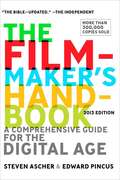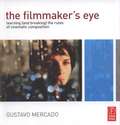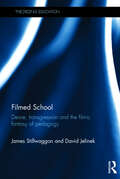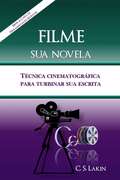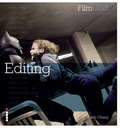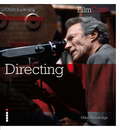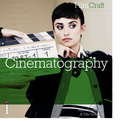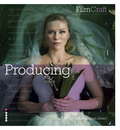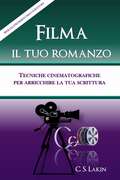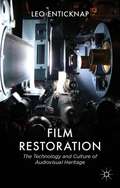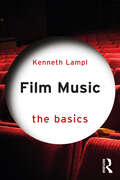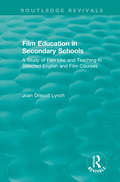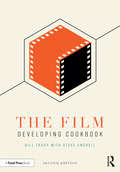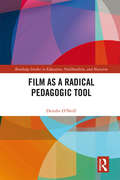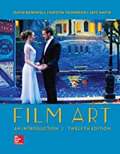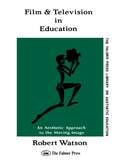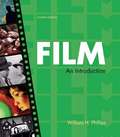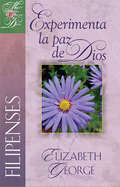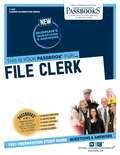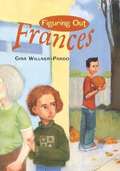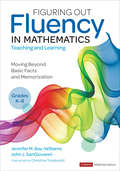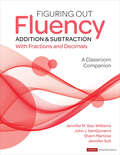- Table View
- List View
The Filmmaker's Handbook 2013: A Comprehensive Guide for the Digital Age
by Steven Ascher Edward PincusThe authoritative guide to producing, directing, shooting, editing, and distributing your video or film. Widely acknowledged as the 'bible' of video and film production, and used in courses around the world, The Filmmaker's Handbook is now updated with the latest advances in HD and new digital formats. For students and teachers, professionals and novices, this indispensable handbook covers all aspects of movie making: <P> * Techniques for making dramatic features, documentaries, corporate, broadcast, and experimental videos and films <P> * Shooting with DSLRs, video, film, and digital cinema cameras <P> * Digital editing with the latest video editing systems <P> * In-depth coverage of lenses, lighting, sound recording, and mixing <P> * The business aspects of funding and producing your project * <P> * Getting your movie shown in theaters, on TV, and on the Web
The Filmmaker's Eye: Learning (and Breaking) the Rules of Cinematic Composition
by Gustavo MercadoThis book combines conceptual and practical instruction on creating polished and eloquent images for film and video with the technical know-how to achieve them. The Filmmaker's Eye is a focused, easy-to-reference guide that shows you how to become a strong visual storyteller through smart, effective choices for your shots.
Filmed School: Desire, transgression and the filmic fantasy of pedagogy (Theorizing Education)
by James Stillwaggon David JelinekFilmed School examines the place that teaching holds in the public imaginary through its portrayal in cinema. From early films such as Mädchen in Uniform and La Maternelle to contemporary images of teaching in Notes on a Scandal and The History Boys, teachers’ roles in film have been consistently contradictory, portraying teachers as both seducers and selfless heroes, social outcasts and moral models, contributing to a similarly divided popular understanding of teachers as both salvific and sinister. In this book, Stillwaggon and Jelinek present these contradictory images of teaching through the concept of transference—the fantastical belief in another’s knowing that founds a teacher’s authority in relation to her students and, to some degree, the public at large. Tracing the place of transference across a century of school films, each chapter demonstrates the persistence of this fantasy in one of the dreams or nightmares of teaching that recurs thematically in school films: the teacher-as-savior, seducer, signifier in a moribund discourse, and sacrificial object. Through these analyses, the authors suggest that something might be missing in our attempts to theorize education when we leave our unthought fantasies of teaching out of the picture. This book will be of key interest to academics, researchers, and postgraduate students in the fields of educational theory, teacher education, philosophy of education, film and media studies, psychoanalysis, sociology of education, curriculum studies, and cultural studies.
Filme Sua Novela
by C. S. Lakin Ana Claudia AntunesQuer escrever um romance com visual poderoso? Filme sua Novela dirige o olhar em profundidade sobre técnica cinematográfica para os escritores de ficção . Nenhum outro livro escrito para o ofício ensina o segredo de como "mostrar, não dizer".Autores de best-sellers de todos os gêneros sabem o segredo para enganchar os leitores- ao mostrar, não dizer, a sua história. Mas os escritores não são ensinados a "mostrar" cenas de forma cinematográfica. Sem um método claro, conciso e preciso para a construção de cenas dinâmicas, um escritor provavelmente vai acabar com uma novela plana e sem vida.Cineastas, roteiristas e diretores de cinema utilizam a técnica cinematográfica para criar obras de artes visuais, e romancistas também podem fazer o mesmo - adaptando seus métodos em sua escrita de ficção.Ao "filmar" o seu romance, você vai turbinar a sua história!Sol Stein, em seu livro Stein na escrita disse: "Os leitores, transformados pelo cinema e TV, estão acostumados a ver histórias. A experiência da leitura. . . é cada vez mais visual. "Romancistas hoje, independentemente do gênero, necessitam aprender a escrever cinematograficamente, porque isso é o que os leitores querem!Lá dentro de "Filme sua Novela", você vai aprender:O verdadeiro segredo para "mostrar, não dizer" e como tudo se insere no "momento"Mais de uma dúzia de "tomadas de câmera" que os romancistas podem tomar emprestado de roteiristas e diretores para criar poderosas cenas Instrução ativa de como montar as peça de planos de câmera em conjunto para criar segmentos de cenas cinematográficasExemplos de romances e roteiros mostrando cada faceta da técnica cinematográficaComo conceber um sistema de imagem temática de planos-chave, motivos, e imagensManeiras de usar cores, formas, sons, e ângulos para efeito subliminar proposital"Filme sua Novela"
FilmCraft: Editing
by Justin ChangThe value of the editor's craft to a finished film cannot be underestimated, and it's no surprise that directors rely heavily on the same editor over and over again. Seventeen exclusive interviews with some of the world's top film editors, including Walter Murch, Virginia Katz, Joel Cox, Tim Squyres and Richard Marks, explore the art of film editing; its complex processes, the relationship with other film practitioners, and the impact of modern editing techniques.The Filmcraft series is a ground-breaking study of the art of filmmaking-the most collaborative and multidisciplinary of all the arts. Each volume covers a different aspect of moviemaking, offering in-depth interviews with a host of the most distinguished practitioners in the field. Forthcoming titles include Cinematography, Directing, Costume Design, Production Design, Producing, Screenwriting, and Acting.
FilmCraft: Directing
by Mike GoodridgeUltimately responsible for the creative content on screen, directors are the captains of the ship on every film. All actors and heads of department report to them. Some directors are also writers, employing unique styles of dialogue and characterizations. Others, like Pedro Almodóvar, create inimitable visual and tonal styles that set their films apart from the crowd. Unlike the other volumes in the FilmCraft series, Directing covers all the disciplines of film art that pass through the director's hands, from development and writing, to working with actors, designers and cinematographers, to post-production and distribution.
FilmCraft: Cinematography (Filmcraft Ser.)
by Mike Goodridge Tim GriersonThe first in the FilmCraft Series, this beautiful book covers the complex craft of cinematography through discussions with notable cinematographers, like Vittorio Storaro and Christopher Doyle. With stills, photos from the sets, and in-depth exploration of both iconic and contemporary projects, from Psycho and the French New Wave classic The Week End to Chicago and Zhang Yimou's saga Hero. Get access to lauded professionals, who provide you with the perspective to think like the pros and create compelling visual stories. Apply the perspective you'll gain to your own work with practical tips, or just sit back and coast along this thoughtful, behind-the-scenes road.
FilmCraft: Cinematography
by Mike Goodridge Tim GriersonAs chief collaborators with the directors on a film, cinematographers are artistic masters in their own right. In Cinematography sixteen of the world's greatest "painters of light" share their insights, anecdotes, and technical achievements through a series of exclusive interviews. Fascinating for both film fans and practitioners, this book is the perfect companion for anyone who wants to stand on the other side of the camera, with some of the greatest film artists of our time.
FilmCraft: Producing (Filmcraft Ser.)
by Geoffrey Macnab Sharon SwartResponsible for hiring all members of cast and crew from the director onwards, the producer's role is central to the making of any film and responsibilities can include everything from script development to securing financing to masterminding a film's marketing campaign. While few film producers are household names, they wield a degree of control that only the biggest-name directors can aspire to. As with all of the FilmCraft titles, this book is based on new indepth interviews and features such greats as Tim Bevan, Marin Karmitz, Jeremy Thomas, Jon Kilik, Lauren Shuler Donner, Jan Chapman, and Peter Aalbæk Jensen.
Filma il tuo romanzo: tecniche cinematografiche per potenziare la tua scrittura
by Emiliana Erriquez C. S. LakinVolete scrivere un romanzo visivamente forte? Filma il tuo romanzo analizza in profondità la tecnica cinematografica per gli scrittori di fiction. Nessun altro libro sul mestiere di scrivere vi insegna il segreto di come "Mostrare, non raccontare". Gli autori di best-seller di ogni genere conoscono il segreto per catturare l'attenzione dei lettori mostrando, non raccontando la loro storia. Ma agli scrittori non viene insegnato come "mostrare" le scene in modo cinematografico. Senza un metodo chiaro, conciso, e preciso per la costruzione di scene dinamiche, uno scrittore probabilmente finirà con il creare un romanzo piatto, senza vita. I registi, gli sceneggiatori utilizzano la tecnica cinematografica per creare capolavori visivi, e gli scrittori di romanzi POSSONO adattare i loro metodi alla loro scrittura narrativa. Con "Filma" il tuo romanzo, è possibile potenziare la vostra storia! Sol Stein, nel suo libro Stein on Writing ha detto, "I lettori, condizionati da film e TV, sono abituati a vedere le storie. L'esperienza di lettura. . . è sempre più visiva." Gli scrittori di romanzi di oggi, indipendentemente dal genere, devono imparare la narrazione cinematografica, perché questo è ciò che i lettori vogliono! All'interno, troverete: Il vero segreto del "Mostrare, non raccontare" e come sia tutta una questione di "momenti" Più di una dozzina di "inquadrature" che gli scrittori di romanzi possono prendere in prestito dagli sceneggiatori e dai registi per creare grandi scene Istruzioni su come mettere insieme le inquadrature per creare segmenti di scena cinematografici Esempi da romanzi e sceneggiature che mostrano ogni aspetto della tecnica cinematografica Come elaborare un sistema di immagine tematico delle principali inquadrature, idee dominanti e immagini Modi per utilizzare colori, forme, suoni, e angoli per un effetto subliminale intenzionale
Film Restoration
by Leo EnticknapThis is the first monograph-length work intended to enable readers with a humanities background and the general public to understand what the processes and techniques of film restoration do and do not involve, attempting to integrate systematically a discussion about related technological and cultural issues.
Film Music: The Basics (The Basics)
by Kenneth LamplA comprehensive introduction to film music, this book provides a concise and illuminating summary of the process of film scoring, as well as a succinct overview of the rich history of contemporary film music. Written in a non-technical style, this book begins by presenting a brief history of film music from the last 30 years, covering topics ranging from blockbuster franchises to indie film scores. It explores film music from around the world, including Bollywood and European Avant-garde cinema, and film music in animation, like Disney-Pixar and Japanese anime. It then offers a guide to the language of film music analysis, the creative process behind composing film music, and the use of current technology. The book champions diversity in the industry, with case studies and interviews from a range of active film composers, including: Pinar Toprak (Captain Marvel, 2019), Kris Bowers (Bridgerton, 2020), Natalie Holt (Loki, 2021), and Rachel Portman (Emma, 1996), Complete with a glossary of key terms and further reading, this book is an invaluable resource for all those beginning to study film music, as well as lifelong film music buffs seeking to update their understanding of film music.
Film Education in Secondary Schools: A Study of Film use and Teaching in Selected English and Film Courses (Routledge Revivals)
by Joan Driscoll LynchPublished in 1983, this book considers how films are used in secondary school as teaching aids in English and Film courses. Based on a dissertation presented to Temple University, the book tackles three main questions: firstly, it explores the ways that film is used be secondary school English teachers as an adjunct to instruction. Secondly it surveys the number and types of courses offered in film study and filmmaking in specific secondary schools. Thirdly it compares and contrasts the extent and degree of teaching about film as an artistic medium of communication.
The Film Developing Cookbook
by Steve Anchell Bill TroopThe Film Developing Cookbook, 2nd edition is an up-to-date manual for photographic film development techniques. This book concentrates on films, their characteristics, and the developers each requires for maximum control of the resulting image. For two decades The Film Developing Cookbook has helped photographers acquire a working knowledge of photographic chemistry—what photo chemicals do and why—for black and white film developing. Now reissued in a revised and fully updated edition, this must-have manual for photographic film development techniques covers films, their characteristics, and the developers each require for maximum control of the resulting image. Readers will learn how to mix and use photographic solutions from scratch, and even how to create new ones. Includes invaluable information about films, developer ingredients, formulas, speed increasing, mixing and storing stock solutions, stop baths, fixers, washing, and chemical safety. A must-have for analog photography enthusiasts and any photography students using the darkroom. For in-depth discussion and questions on all things film or darkroom join the Darkroom Cookbook Forum, www.darkroomcookbook.com
Film as a Radical Pedagogic Tool (Routledge Studies in Education, Neoliberalism, and Marxism #15)
by Deirdre O'NeillEmerging from Inside Film, a project that helps prisoners and people on probation make their own films, this book discusses the need for working class people to represent themselves and challenge mainstream stereotypes and assumptions about them. This project gave prisoners and parolees the technical skills necessary to make their own films and tell their own stories in order to counter the ways they have been misrepresented. The author demonstrates that film and television are key means by which socioeconomically marginalized groups are classified according to hegemonic norms, as well as the ways such groups can undermine these misrepresentations through their use of the media. As a theoretical reflection on the Inside Film project and the relationship between filmmaking and education, this book explores what radical pedagogy looks like in action.
Film Art: An Introduction
by David Bordwell Kristin Thompson Jeff SmithFilm is an art form with a language and an aesthetic all its own. Since 1979, David Bordwell, Kristin Thompson and now, Co-Author, Jeff Smith's Film Art has been the best-selling and most widely respected introduction to the analysis of cinema. Taking a skills-centered approach supported by examples from many periods and countries, the authors help students develop a core set of analytical skills that will enrich their understanding of any film, in any genre. In-depth examples deepen students' appreciation for how creative choices by filmmakers affect what viewers experience and how they respond. Film Art is generously illustrated with more than 1,000 frame enlargements taken directly from completed films, providing concrete illustrations of key concepts. Along with updated examples and expanded coverage of digital filmmaking, the twelfth edition of Film Art delivers SmartBook, first and only adaptive reading experience currently available, designed to help students stay focused, maximize study time and retain basic concepts.
Film And Television In Education: An Aesthetic Approach To The Moving Image
by Robert WatsonFirst published in 1990. Routledge is an imprint of Taylor & Francis, an informa company.
Film: An Introduction
by William H. PhillipsFilm: An Introduction covers the movies students know and the films their instructors want them to know -- including the silent classics of D. W. Griffith and Sergei Eisenstein, the Hong Kong cinema of John Woo, the documentaries of Errol Morris and Michael Moore, and the contemporary films of Quentin Tarantino and Peter Jackson. Through meticulous coverage, an unmatched art program with over 500 frame enlargements, accessible language, and unique study tools, Film helps beginning students develop the critical skills they need to analyze films and understand the medium in all its variety.
Filipenses: Experimenta la paz de Dios
by Elizabeth GeorgeVivimos paralizados cuando no sabemos cómo reconciliarnos con nuestro pasado. Algunos creen que "el pasado no importa" y procuran reprimir el dolor una vez tras otra. Otros no logran renovarse y cambiar porque creen que el pasado es más importante que su
File Clerk: Passbooks Study Guide (Career Examination Series #C-254)
by National Learning CorporationThe File Clerk Passbook® prepares you for your test by allowing you to take practice exams in the subjects you need to study. It provides hundreds of questions and answers in the areas that will likely be covered on your upcoming exam, including but not limited to: Filing Practices, Indexing, Sorting and Cross-Referencing; Equipment and Terminology; Organizing Data into Tables and Records; Understanding and Interpreting Written Material; and more.
Figuring Out Frances
by Gina Willner-PardoWith a light touch, this insightful novel charts a fourth grader's course through the complexities of family and friendship. Abby is trying hard to understand the things that puzzle her. One is her friendship with Travis Mooney, who seems to be turning into just another obnoxious boy. Another is a mystery: Why does Grandma, who has Alzheimer's disease, sometimes call her Frances? Who is, or was, Frances? Abby is convinced that if she can figure out Frances, she will know something new and important about herself. Along with the surprising and satisfying solution to this mystery comes the discovery that some things can't be figured out but just as in doing a puzzle, putting all the pieces together is the fun part.
Figuring Out Fluency in Mathematics Teaching and Learning, Grades K-8: Moving Beyond Basic Facts and Memorization (Corwin Mathematics Series)
by John J. SanGiovanni Jennifer M. Bay-WilliamsBecause fluency practice is not a worksheet. Fluency in mathematics is more than adeptly using basic facts or implementing algorithms. Real fluency involves reasoning and creativity, and it varies by the situation at hand. Figuring Out Fluency in Mathematics Teaching and Learning offers educators the inspiration to develop a deeper understanding of procedural fluency, along with a plethora of pragmatic tools for shifting classrooms toward a fluency approach. In a friendly and accessible style, this hands-on guide empowers educators to support students in acquiring the repertoire of reasoning strategies necessary to becoming versatile and nimble mathematical thinkers. It includes: "Seven Significant Strategies" to teach to students as they work toward procedural fluency. Activities, fluency routines, and games that encourage learning the efficiency, flexibility, and accuracy essential to real fluency. Reflection questions, connections to mathematical standards, and techniques for assessing all components of fluency. Suggestions for engaging families in understanding and supporting fluency. Fluency is more than a toolbox of strategies to choose from; it’s also a matter of equity and access for all learners. Give your students the knowledge and power to become confident mathematical thinkers.
Figuring Out Fluency in Mathematics Teaching and Learning, Grades K-8: Moving Beyond Basic Facts and Memorization (Corwin Mathematics Series)
by John J. SanGiovanni Jennifer M. Bay-WilliamsBecause fluency practice is not a worksheet. Fluency in mathematics is more than adeptly using basic facts or implementing algorithms. Real fluency involves reasoning and creativity, and it varies by the situation at hand. Figuring Out Fluency in Mathematics Teaching and Learning offers educators the inspiration to develop a deeper understanding of procedural fluency, along with a plethora of pragmatic tools for shifting classrooms toward a fluency approach. In a friendly and accessible style, this hands-on guide empowers educators to support students in acquiring the repertoire of reasoning strategies necessary to becoming versatile and nimble mathematical thinkers. It includes: "Seven Significant Strategies" to teach to students as they work toward procedural fluency. Activities, fluency routines, and games that encourage learning the efficiency, flexibility, and accuracy essential to real fluency. Reflection questions, connections to mathematical standards, and techniques for assessing all components of fluency. Suggestions for engaging families in understanding and supporting fluency. Fluency is more than a toolbox of strategies to choose from; it’s also a matter of equity and access for all learners. Give your students the knowledge and power to become confident mathematical thinkers.
Figuring Out Fluency - Addition and Subtraction With Fractions and Decimals: A Classroom Companion (Corwin Mathematics Series)
by Jennifer M. Bay-Williams John J. SanGiovanni Sherri L. Martinie Jennifer SuhBecause fluency practice is not a worksheet. Fluency in mathematics is more than adeptly using basic facts or implementing algorithms. It is not about speed or recall. Real fluency is about choosing strategies that are efficient, flexible, lead to accurate solutions, and are appropriate for the given situation. Developing fluency is also a matter of equity and access for all learners. The landmark book Figuring Out Fluency in Mathematics Teaching and Learning offered educators the inspiration to develop a deeper understanding of procedural fluency, along with a plethora of pragmatic tools for shifting classrooms toward a fluency approach. Now, teachers have the chance to apply that inspiration through explicit instruction and practice every day with the classroom companion Figuring Out Fluency: Addition and Subtraction with Fractions and Decimals. With this book, teachers can: Dive deeper into the Significant Strategies for fluency explained in the anchor book Learn how these strategies grow from and relate to the basic fact strategies children learn Access over 100 strategy-aligned and classroom-ready activities for fluency instruction and practice in adding and subtracting fractions and decimals, including worked examples, routines, games, and centers Find activities for assessing all components of addition and subtraction fluency for fractions and decimals, plus support for engaging families Download all of the needed support tools, game boards, and other resources from the companion website for immediate implementation. Give each and every student the knowledge and power to become skilled and confident mathematical thinkers and doers.
